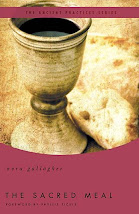.

So let's start this week with a disclaimer: I've never been a fan of waiting. For anything. And so because God has such a well-developed sense of humor, I've ended up working in the church. Go figure.
AND ... I love how Nora invites us to consider waiting not "prelude to" but "part of" the sacramental circle that calls us to the table and sends us out into the world. It's another one of those "both/and" things -- like this quote from page 28:
The language of the altar is old, much older than us. And it's also new, being made you and and the people around you.Amen.
Another part I loved about this chapter was her admission (on page 29): "I am not a light traveler."
Ironically, I was working on this reflection on the plane yesterday -- a flight from L.A. to Chicago for the Episcopal Urban Caucus that was delayed because there was more "carry-on luggage" than there was room for.
And so as I sat in 15F watching one traveler after another trying to cram "one more thing" in the already full overhead compartments, I wondered if it wasn't kind of a metaphor for what it looks like to God as we try to in cram "one more thing" into our already full schedule, agenda, closet, suitcase, briefcase, or hard-drive.
A Lent or two ago we used the image of "UNpacking for the Lenten Journey" -- and I liked that image a lot ... although, like Nora, I fear I took the "admire rather than emulate" approach. Much easier to take on than to let go.
Other notes on Chapter 3:
I appreciated her take on (and her "taking on"!) the Sodom & Gomorrah story from Genesis -- and the way she artfully wove it together with the Gospel challenge to Empire. Another both/and moment:
Jesus' "kingdom of God" may not be a far-off heaven, but may instead be an alternative to the kingdom of Rome, an alternative to the monetary, social, moral, and legal economy of the Roman Empire and the religious authorities who collaborated with it. An alternative to waste and corruption and greed. Jesus promises us the kingdom of heaven: more compassion, more love, more justice, more courage, more surprise.And here -- finally -- is my favorite image:
Where can we, do we and might we use that power of subversive inspiration to help bring on earth that kingdom of heaven we pray for every time we gather for the Sacred Meal? And -- as Nora asks -- what did we do last week to find the kingdom of heaven in our midst ... and to help others find it?



